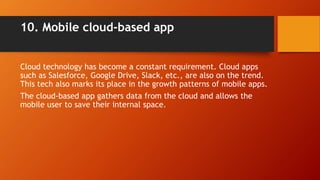Android app development trends for 2021
- 1. Android App Development Trends for 2021 extract
- 2. 1. Artificial Intelligence AI increased by 300 percent from 2018-2019, as reported by Gartner. Therefore, using AI technology in mobile apps calls for optimum opportunities for business growth. Also, it will allow you to stand out from the others. AI improves user interest in the mobile app. Several businesses are implementing this technology to automate the job, saving much money. After seeing the advantages of AI in the mobile world, tech giants like Facebook, Microsoft, Google, and IBM have also started investing in it.
- 3. 2. Chatbot Chatbots are changing how businesses communicate with their customers. In the past, businesses communicated with their customers via cell phone calls (which was quite time-taking). Today, however, is the age of chatbots. This breakthrough responds to customer requests more quickly and more efficiently. The technology is prevalent in the app that includes online shopping, transportation, food delivery, etc. Chatbots are a human way of communicating and help businesses fulfill the needs of their customers. Below are the most common chatbot solutions: -Siri -Alexa -Google Assistant
- 4. 3. 5G Technology 5G tech is one of the top trends in mobile app development in 2021. 5G is identified as 100 times faster than 4G at a speed of 100 Gbps. 5G is used for applications such as video streaming. Besides, several companies are developing applications with 5G technology to increase their productivity. This tech has low latency and therefore increases user experience with the app.
- 5. 4. Internet of Things: (IoT) Growth in the telecom & mobile sector has led to the creation of IoT. This technology is known to deliver automation on various devices, such as smartphones, smartwatches, TVs, and more. IoT is the center of Smart Home and Smart City building. It is also wise to implement this technology in mobile apps as well.
- 6. 5. M-Commerce trends M-Commerce is booming today. The growing demand for online shopping has made the M-Commerce trend a necessity for online marketers. M-commerce is a technology that manages to purchase and sell goods and services using wireless devices. Smartphone users are in significant numbers. So, using the m-commerce app, you can quickly impact a broad audience.
- 7. 6. AR and VR Since the release of ARCore and ARKit by tech giants like Apple and Google, the mobile app development industry has grown dramatically. The AR and VR apps can be viewed in various industries, such as education, 3D video games, entertainment, shopping, healthcare, travel, and more.
- 8. 7. Mobile wallets Mobile wallet apps are a trend due to the simple and convenient way to pay bills. Various industries use this app form for online transactions. Paytm, PayPal, GooglePay, PhonePe, Android Pay are only a few examples of mobile wallet applications. These wallets store user information, such as a debit or credit card, and this information is used at the transaction time.
- 9. 8. Foldable Apps Foldable smartphones are only a fraction of the smartphone industry. This is going to transform the IT industry in the coming years. As recorded by the States, 19 percent of Android clients and 17 percent of iOS clients are eager to buy a foldable smartphone.
- 10. 9. Beacon Technology This is a new brand in the technology community. They are common in sectors such as hotels, retail, and healthcare. This technology brings high-level features to mobile applications. Entrepreneurs use this technology to monitor customer behavior in shops. This technology can easily monitor the amount of time a single purchaser takes after the product.
- 11. 10. Mobile cloud-based app Cloud technology has become a constant requirement. Cloud apps such as Salesforce, Google Drive, Slack, etc., are also on the trend. This tech also marks its place in the growth patterns of mobile apps. The cloud-based app gathers data from the cloud and allows the mobile user to save their internal space.










